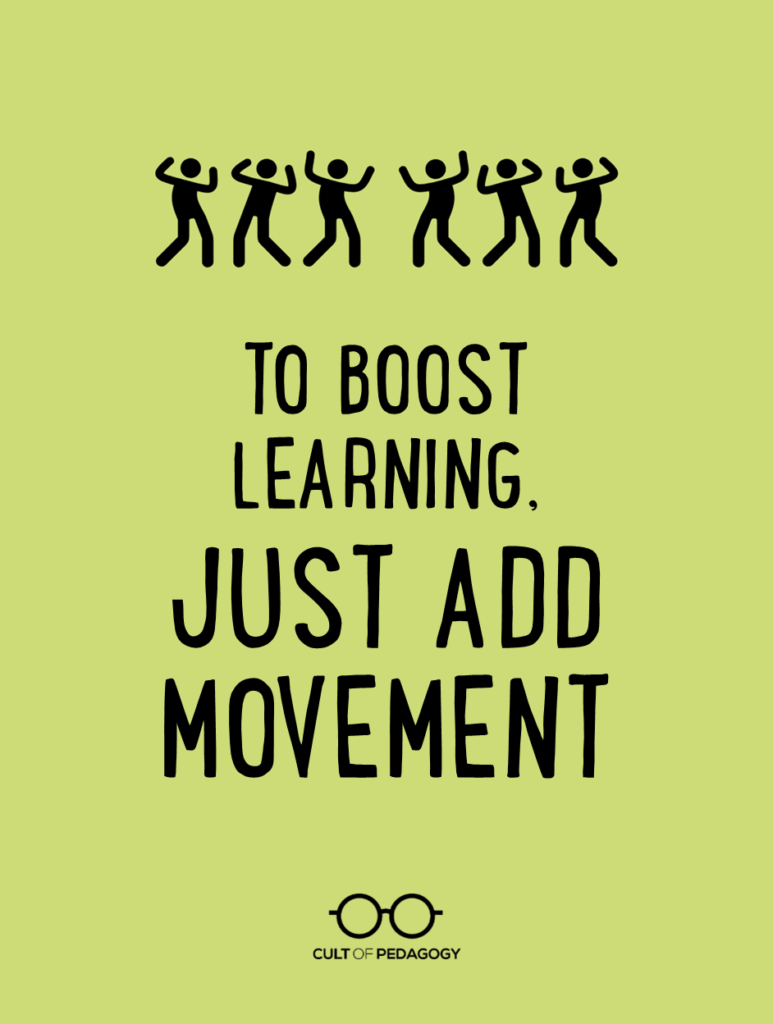
Listen to this post as a podcast:
Sponsored by Pear Deck and NewseumED
This page contains Amazon Affiliate and Bookshop.org links. When you make a purchase through these links, Cult of Pedagogy gets a small percentage of the sale at no extra cost to you. What’s the difference between Amazon and Bookshop.org?
If you were to start singing “The Itsy-Bitsy Spider” right now, I bet you’d have a hard time keeping your hands still. That’s because most of us who know the song learned it with gestures, and things we learn with physical movement tend to stick.
We can apply that same principle to classroom learning, using movement to enhance learning from preschool all the way through college. Let’s take a look at what the research says about movement-based learning, then explore six different ways you can add more movement to your instruction.
The Research on Movement
The concept of “learning styles” has overwhelmingly been labeled a myth by researchers, so attempting to determine which of your students are kinesthetic learners will not be a good use of your time. What is worth your time is using movement when working with all learners, because plenty of research backs that up.
- In general, people learn better when information is presented in more than one way (Sankey, Birch, & Gardiner, 2010). In other words, if we take in information through more than one sense, we’re more likely to encode it in long-term memory. This would include visual, verbal, and kinesthetic modes of learning.
- Specifically, the use of gestures results in more enduring learning than learning without gestures (Cook, Yip, & Goldin-Meadow, S, 2010). So even the addition of a few small hand gestures can have an impact on how well students remember material.
- Study after study shows that physical activity activates the brain, improves cognitive function, and is correlated with improved academic performance (Donnelly & Lambourne, 2011). This means any kind of physical activity, not just movement associated with the material we’re learning, can benefit students academically.
Six Ways to Add Movement to Instruction
1. Total Physical Response
Developed for use with second-language learners in the 1960’s (Asher, 1966), Total Physical Response simply has students act out physical gestures to represent vocabulary words. Shown to be highly effective with both children (Singh, 2011) and adults (Carruthers, 2010), TPR can also be used to help learners remember new vocabulary terms in their native language. In other words, it can be used in any content area, with any student.
This video from the Teacher Toolkit shows Texas teacher Michael Rowland using TPR with his third grade students, who are English learners.
And here is Craig Gaslow, another Texas teacher who teaches AP Human Geography, demonstrating how he uses TPR to teach three different models of diffusion:
Finally, here are Scott Causer’s high school students demonstrating a few earth science processes using TPR:
What strategies support learning? Here’s high school science using TPR to recall processes in Earth Science -thanks Mr. Causer and team for modeling! @ESMSchoolDist @cultofpedagogy pic.twitter.com/njoAaVdBB9
— Naomi Trivison (@NaomiTrivison) March 30, 2019
2. Tableau/Snapshot
In this strategy, students create a physical “snapshot” with their bodies, a still picture that represents an idea.
This example, demonstrated by 4th grade teacher Stefannie Cundiff, comes from Teacher Toolkit:
Another example is explained in this Slides presentation by Tyler Jacobs, an Idaho-based high school ELA and social studies teacher. Click the image below to view the slideshow in a new window:
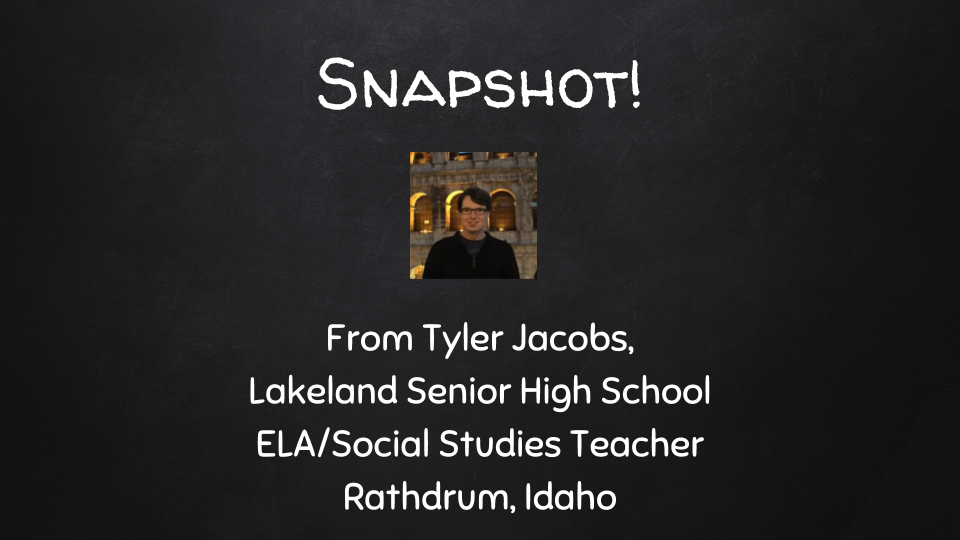
3. Simulations
In these, students demonstrate a concept with some kind of motion or interactivity. They could represent non-human components, like in the examples below, or they might actually take on the role of humans in a re-enactment of an event.
The example below comes from the University of British Columbia, where electrical engineering professor Matthew Yedlin has students simulate the difference between linear growth and exponential growth:
Here’s a different kind of simulation demonstrated by Amy Tepperman, where participants show fractions by placing different body parts on the floor, Twister-style:
An important note about simulations: If you are doing simulations about historical periods or events, proceed with caution. Many, many teachers have ended up traumatizing students with these types of simulations. This article from Learning for Justice explores the topic in depth.
4. Songs with Movement
Songs are another powerful way to teach concepts to students, and if the songs also incorporate movement, even better.
Dan Adler, a 6th grade science teacher in Lawrence, MA, regularly uses songs with physical movements to help his students remember challenging concepts. In this video, students demonstrate “Bodak Particles,” a song about phase change sung to an instrumental version of Cardi B’s song “Bodak Yellow.” (Get a copy of the lyrics here.)
Check out our science scholars rapping about phase changes! pic.twitter.com/uO3sJQubgw
— UP Academy Leonard (@up_leonard) November 8, 2018
5. Virtual and Augmented Reality
The experiences offered by virtual and augmented reality allow students to move around in and interact with virtual objects and spaces in ways that would be difficult if not impossible to pull off in the real world.
Augmented Reality layers digital enhancements on top of objects in the real, physical world. Using a device, like a smartphone, loaded with AR software, users point it at a picture or physical object, and the software brings up some kind of digital element like a 3D animation, text, or a video. (Pokémon Go is an example of an AR game.)
One set of AR tools that have tremendous learning potential comes from a company called Merge. Their Merge Cube is a handheld cube that can “become” a variety of objects when paired with the Merge Goggles, as shown below:
Virtual Reality immerses the user in a 360-degree environment, a computer-generated simulation, viewable through a VR headset, and allows them to move through and interact with that environment.
One outstanding source for VR experiences is Google Expeditions, which offers tours to over 500 different locations: historical landmarks, national and state parks, underwater sites, and up-close studies of scientific phenomena.
And if you don’t find the exact tour you want, you and your students can even create your own expeditions with Google Tour Creator.
6. Brain Breaks
I left this one for the end because it’s the easiest to implement. This brain breaks guide from the University of Texas summarizes the research on the connection between movement and academic achievement and offers dozens of ideas for brain breaks that can be put into action immediately.
Brain break videos are super easy to find on YouTube, especially for younger kids. My daughter came home from first grade years ago excited to demonstrate this one for me:
But what about older kids? High school math teacher David Sladkey has written a a book, Energizing Brain Breaks (Amazon | Bookshop.org), that has ideas for all ages, even middle and high school kids who may not be as comfortable with the Tooty Ta. in this video, students demonstrate a simple toe-tapping brain break:
Tips for Getting Started
- Don’t overdo it. Attempting to add a movement component to every concept students learn would not only be too time-consuming, it could also get old, shifting from a fun novelty to something that causes students to slump over in their seats and say, Not THAT again!!
- Get input from students. When coming up with gestures or movements, you don’t have to rely solely on your own brain. Ask students to help you come up with ideas. Involving students in the process will help them remember concepts better and will increase the likelihood that you’ll end up with really effective movements.
- Know what works for your students. Some of your students may not be comfortable with or physically able to do certain movements, so keep that in mind and make modifications based on ability and need.
- Use movement for retrieval practice. Rather than using movement in a single lesson, apply the principles of retrieval practice by repeating the movements in short practice sessions, spacing them out over time, and interleaving concepts with one another.
- For younger students, meaningful gestures matter more. While adults learn from both iconic gestures (those that have some meaning in relation to the concept they are connected to) and beat gestures (those that have no inherent meaning but are just tied to particular “beats” in a sentence or phrase), younger children learned more from iconic gestures (So, Sim Chen-Hui, & Low Wei-Shan, 2012). So when working with younger students, try to make the gestures match the concepts in some way.
References
Asher, J. J. (1969). The total physical response approach to second language learning. The modern language journal, 53(1), 3-17.
Carruthers, S. W. (2010). The total physical response method and its compatibility to adult ESL-learners. Retrieved from http://tesolteachers.net/t.pdf
Cook, S. W., Yip, T. K., & Goldin-Meadow, S. (2010). Gesturing makes memories that last. Journal of memory and language, 63(4), 465-475.
Donnelly, J. E., & Lambourne, K. (2011). Classroom-based physical activity, cognition, and academic achievement. Preventive medicine, 52, S36-S42.
Sankey, M., Birch, D., & Gardiner, M. (2010). Engaging students through multimodal learning environments: The journey continues. In Proceedings ASCILITE 2010: 27th annual conference of the Australasian Society for Computers in Learning in Tertiary Education: Curriculum, technology and transformation for an unknown future (pp. 852-863). University of Queensland.
Singh, J. P. (2011). Effectiveness of total physical response. Academic Voices: A Multidisciplinary Journal, 1, 20-22.
So, W. C., Sim Chen-Hui, C., & Low Wei-Shan, J. (2012). Mnemonic effect of iconic gesture and beat gesture in adults and children: Is meaning in gesture important for memory recall?. Language and Cognitive Processes, 27(5), 665-681.
Join our mailing list and get weekly tips, tools, and inspiration that will make your teaching more effective and fun. You’ll get access to our members-only library of free downloads, including 20 Ways to Cut Your Grading Time in Half, the e-booklet that has helped thousands of teachers save time on grading. Over 50,000 teachers have already joined—come on in.


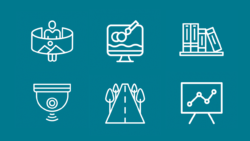
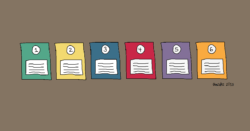
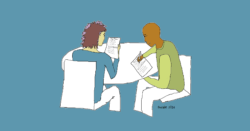
So happy to read this post— I couldn’t agree more about how all types of learning is enhanced and reinforced by adding movement. I just presented at TESOL in Atlanta about using some activities such as build it break it, cross the room as if and human slide show to provide access to complex text for ELL students. My website (richardsilberg.com) is devoted to drama activities (mostly movement based)for English language teaching and has video examples of many activities (I list your blog as a valuable resource for teachers) that your readers might find helpful. I’ve been an admirer of your work for quite some time now, especially around technology.
Hey Richard,
Thanks so much for sharing this!
I just bought an inexpensive set of VR googles on Amazon! Looking forward to trying out Google Expeditions and seeing how I can use VR/AR when teaching scifi novels. Perfect timing, considering my students and I start our last scifi novel on Tuesday.
A great way to add TPR to vocabulary is American Sign Language. My high schoolers study ACT words in categories and use one ASL gesture for each set of words: “nice” = affable, amiable, congenial, cordial, and harmonious; “mean” = belligerent, cantankerous, contentious, inimical, and pugnacious.
Your blog is very informative, Thank You for share.
I love CULT OF PEDAGOGY!
This is so nice to hear, Jaime – glad you’re enjoying the resources!
As always, this site has a treasure trove of things to do in the classroom to bring energy into learning and making movement an integral part of the holistic process. Thank you very much for putting all these strategies under one roof- this is my every-now-and-then go to site to revisit and recharge for a new approach and fresh perspective
Thank you! I shared this with my school!
I started using brain breaks this year and after some learning with our special ed department, I learned that what we do after the brain break (a large/heavy movement and the cool down) are just as important to get us focused again to learn.
Katrina,
Thanks for sharing this! So glad to hear that you were able to include brain breaks for your students!
I work as a teacher-trainer in Lao PDR.
I came across your post Too Boost Learning, Just Add Movement, and it was perfect because I had already planned on working with the students on using TPR. I also wanted to show them other ways of using movement as well. Thanks to your blog and the book Brain-Powered Strategies to Engage All Learners by LaVonna Roth. We had a very successful workshop! I have attached a few pictures for you to enjoy!
Want to see pics????https://drive.google.com/drive/folders/1KVC9hDwI7WiZ214G4y1neQVE6bOipeLr?usp=sharing
Movement is especially great for math learners! Many of our kids slip into a coma when we pull out a worksheet. 🙂
Do a Google search for “Jump 2 math”
They have so many kinesthetic math moves on their website.
I LOVE your insights towards teaching.
As a future teacher, this is very helpful. I cannot wait to do apply these concepts within my own classroom.
Cult of Pedagogy is great!!!!
So cool! The Google Tour Creator video is from the high school my kids will go to! I am a newly certified ESL program specialist… trying to get my foot back in the door.
Jennifer, thank you for this post! So many great ideas. I can’t wait to try some of these out next school year!
Hello Jennifer Gonzalez,
My name is Brandy Guerrero, and I am studying to become an elementary school classroom teacher. I am interested in knowing more about how you decide when to offer movement breaks. You mentioned in the Tips For Getting Started section that you should not overdo it. Offering movement is an excellent way for students to get on their feet and learn more about different concepts; however, you can’t use it all the time because it can become time-consuming. With that in mind, should you have them moving more in the morning or afternoon?
I appreciate any thoughts and tips!
Hi Brandy, this is Andrea from Jenn’s team. I actually use movement in the classroom as a teacher myself every day, and I consider it an important part of teaching. Sometimes it’s as simple as getting everyone on their feet for one minute of stretching and jumping. Other times, I build movement into the lesson using activities that require students to move around the classroom, just like the ones described in the post. Once you get to know your students, you’ll know when they need a change of pace because they’ll be less focused, less alert, and more prone to distractions. Morning or afternoon, getting the oxygen flowing will wake them up and make them feel refreshed and ready for the next task.
Hello current teachers, I am studying to become an elementary school classroom teacher and am interested in knowing more about activities that include learning while moving. I think movement is so important and I would love some ideas on how to integrate movement and learning. I appreciate any thoughts!
Ellie, if you haven’t already, I would encourage you to scroll up and take a look at some of the video resources embedded in this post. Also, if you scroll through the comments section, there are several that provide links to resources that other teachers have either created or found useful as they incorporate movement in their classrooms. I hope this is helpful, and I wish you the best in your studies!
I was impressed with the usage of technology in the classroom and taking the students to a different location around the world.
Love this podcast along with the videos.
Jenn will be so glad to know that you’ve found the resources to be helpful!